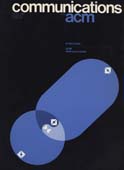October 1980 - Vol. 23 No. 10

Features
Logical construction of software
The authors contend that it is both possible and necessary to clearly demark and explicitly define the transition between the software design and software implementation phases of the software life cycle. The output of the software design phase is defined to be a logical design of software, and the logical design can be described explicitly if the software is viewed as a system of data sets and data transforms. Logical Construction of Software (LCS) is a software design methodology that guides the designer in defining and describing these software components and their relationships. The methodology is illustrated via a practical application.
The natural language of interactive systems
The work reported here stems from our deep belief that improved human engineering can add significantly to the acceptance and use of computer technology.
In particular, this report describes an experiment to test the hypothesis that certain features of natural language provide a useful guide for the human engineering of interactive command languages. The goal was to establish that a syntax employing familiar, descriptive, everyday words and well-formed English phrases contributes to a language that can be easily and effectively used. Users with varying degrees of interactive computing experience used two versions of an interactive text editor; one with an English-based command syntax in the sense described above, the other with a more notational syntax. Performance differences strongly favored the English-based editor.
A model of shared DASD and multipathing
This paper presents a model of an I/O subsystem in which devices can be accessed from multiple CPUs and/or via alternative channel and control unit paths. The model estimates access response times, given access rates for all CPU-device combinations. Central to the model's algorithm is the estimation of the rotational position sensing (RPS) miss probabilities by means of the maximum entropy principle.
Performance differences strongly favored the English-based editor.
Computational algorithms for product form queueing networks
In the last two decades there has been special interest in queueing networks with a product form solution. These have been widely used as models of computer systems and communication networks. Two new computational algorithms for product form networks are presented. A comprehensive treatment of these algorithms and the two important existing algorithms, convolution and mean value analysis, is given.
Analysis of locking policies in database management systems
Consistency control has to be enforced in database management systems (DBMS) where several transactions may concurrently access the database. This control is usually achieved by dividing the database into locking units or granules, and by specifying a locking policy which ensures integrity of the information. However, a drawback of integrity enforcement through locking policies is the degradation of the global system performance. This is mainly due to the restriction imposed by the locking policies to the access of transactions to the database, and to the overheads involved with the management of locks. A framework for the quantitative analysis of the impact of these factors on the performance of DBMS is presented in this paper. In a first step, the main factors which determine the behavior of these systems are pointed out and analyzed independently. The results hereby obtained are aggregated in a second step to yield a global performance evaluation. Throughout this hierarchical modeling approach various analytical techniques are used and the results are illustrated by numerical examples. The paper concludes by pointing out the final results' sensitivity to some basic assumptions concerning transaction behavior and the need for more experimental studies in this area.



